As the harvests are rolling in, there are many decisions to be made about the best way to store our produce.
Eggplant is a bit of a challenge because it is a high moisture containing, low-acid vegetable which is difficult for canning. There are freezing options but if we are preparing our produce and may not be able to rely on electricity to keep the freezer going, canning is always a great option. Once the hard work is over, properly canned products can be safe for consumption for several years.
Here is one of the best recipes for eggplant which deal with eliminating some of that high-water content, as well as a brief overview of pressure canning which is the go-to solution when canning low-acid vegetables.
This is by no means an exhaustive study of safe canning practices and this recipe could be considered intermediate to advanced canning skills. For novice canners, starting with hot water bath canning of high-acid fruits and vegetables, and pickles may be a great idea.
Related: 7 Deadly Canning Mistakes Even Smart People Make
Pressure Canned Roasted Pepper and Eggplant Relish (6 pints)
Ingredients
- 2 large red bell peppers
- 2 large orange bell peppers
- 2 large yellow bell peppers
- 4 medium eggplants
- 2 large tomatoes or 4 roma tomatoes
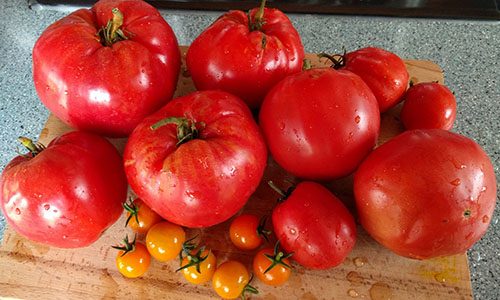
- 4 medium carrots
- 2 large onions
- 6 cloves garlic
- 2 tablespoons fresh oregano
- 2 tablespoons fresh basil
- salt to taste
Preparing the Ingredients
#1. Eggplants
Thoroughly wash eggplants. Slice eggplants into ½ inch slices and spread on cookie sheets. At this stage you may wish to season the eggplant with salt, herbs, paprika, or a drizzle of lemon juice or extra virgin olive oil. Eggplant gives many opportunities to be creative and play with different flavors. Whatever you have on hand will add your special flare to this relish.
Roast in the oven for 30 to 35 minutes until browning and slightly caramelized. If cooking on a grill or outside, use your best judgement of doneness. The idea here is to bring out the best flavors while drying out the eggplant. Remove from heat and let cool.
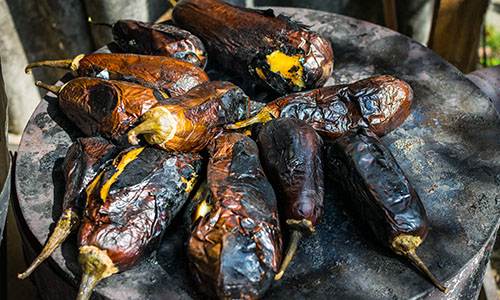 #2. Peppers
#2. Peppers
Roast and blacken the peppers under the broiler, moving them around to blacken as much of the skin as possible. Place in a paper bag or container with a lid and allow to cool. This will make removing the blackened skin easier. Once cool, remove the skin and rinse the roasted peppers. Rough chop the peppers and set aside.
#3. Tomatoes, Carrots, Onions
Wash, core, and quarter tomatoes and place in food processor.
Trim the top of the carrots. Only peel if you feel it is necessary. Some find leaving the peel on can add bitterness to recipes, so it is up to you. Rough chop and place in food processor.
Peel and core onion. Roughly chop and place in food processor.
Process tomatoes, carrots, and onions to a roughly oatmeal consistency.
In a large sauté pan, in a couple of tablespoons of cooking oil, sauté tomatoes, carrots, and onions on low heat for 10 to 15 minutes and set aside.
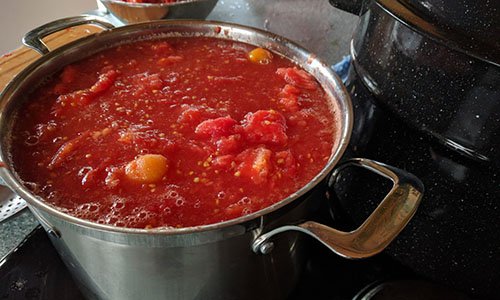 #4. Food Processor
#4. Food Processor
In the food processor, add roasted eggplant, remaining ingredients of garlic, and fresh herbs. Blend into a smooth consistency.
#5. Mixing
In a large bowl, combine roughly chopped roasted peppers, sauteed tomatoes, carrots, and onions, and the blended eggplant. Salt to taste.
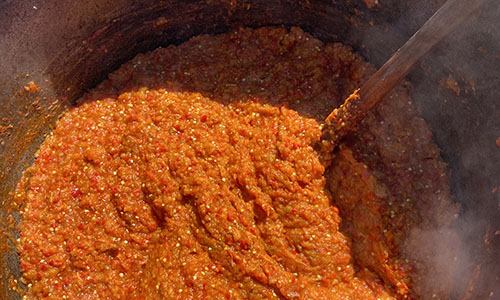 Canning
Canning
Sterilize 6- to 7-pint jars – boil for a minimum of 10 minutes.
*Save yourself some cleanup while increasing your canning safety by filling your jars using a canning funnel.
Related: 10 Long Shelf-Life Canned Foods Every Prepper Should Consider Stockpiling
Fill jars leaving 1 inch of head space. Wipe jar lip with sterile cloth. Place on snap lid with ring.
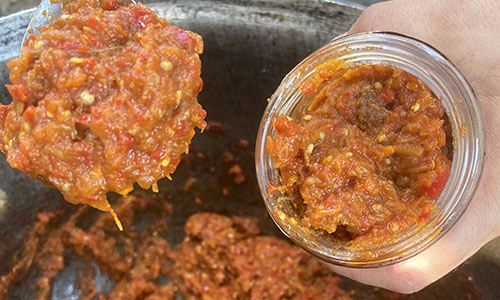
Place jars in pressure canner, ensuring water is two inches above the tallest lid.
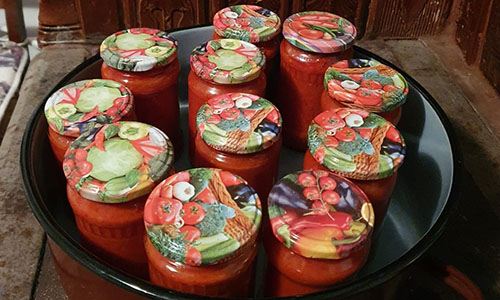
Process for 40 minutes at 10 PSI. If you live over 1000 ft elevation, process at 15 PSI.
*Let pressure canner depressurize. Follow the pressure canner instructions.
Remove from pressure canner and let cool. If the seal does not pop (sink down into itself) it is NOT sealed and should be refrigerated and consumed within a week.
Now we have canned our eggplant and peppers for a long-time storage.
We can enjoy the delicious relish for many months to come, with bread or crackers, as a side dish or anytime we need to add a little flavor boost to any meal.
You may also like:
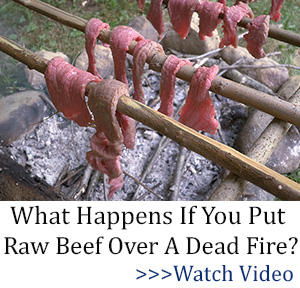 Canning Meatloaf for Meals in a Jar
Canning Meatloaf for Meals in a Jar
The Most Powerful Medicinal Plants You Should Have When SHTF (Video)
Tents That Turn Into Bunkers if You Just Add Water
What Kind Of Guns Are Best Stored To Leave As An Inheritance
How To Make Delicious Lard With 2 Years Shelf-Life (+ 5 Tasty Recipes)

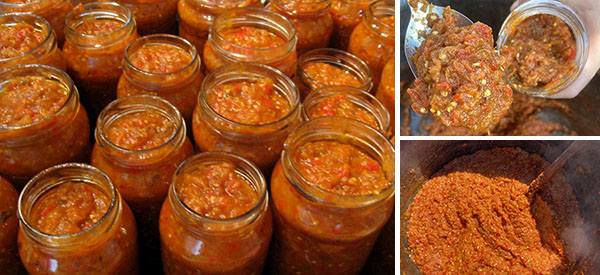













Not sure how much “canning” this person has done, you don’t cover the jars for pressure canning. You do if you are water bath canning. Water Bath canning is used for high acid food only. Low acid foods will need to be pressured canned. The picture shows one piece lids, all the canning I’ve done uses 2 piece lids so as to vent the expanded air from the jars.
Two problems with canning eggplant, it is too acidic to can safely and it is too dense to insure it heats to proper temperature. This recipe addresses both issues, the tomatoes will raise the pH to a safe level and pureeing everything allows it to heat evenly through and through. I would can it (and everything) at 11 pounds instead of ten, 11 is the magic number for killing botulism spores, even with an acidic product I feel better at 11, actually my All American is most stable at 13 pounds and I end up canning everything at 13 because I don’t have to worry about the pressure changing if I’m doing something else. I like eggplant, guess this recipe suggests South Asian cooking, or a nutritious baby food if your babies like it spicy.
Ivy Mike. You got it backwards – egg plant has . a basic ph ( Greater than 7) and tomatoes have an acidic one ( less than 7) . I know, chemistry definitions are a pain! You are correct in being careful with canning basic foods like meat, egg plant etc which, as you pointed out, absolutely need to be processed in a pressure canner. Lots of canning manuals available with detailed instructions – The Ball Blue Book Guide to preserving is a good source.
Busted! I cheated my way through high school chemistry. Little tiny formulas written on my big pink eraser. My 1st instinct was that this eggplant recipe should also include lemon juice or citric acid to acidify it, upon further review I think it should. In fact, just for my peace of mind I think I’m going to put Citric Acid in every vegetable I pressure can from now on, especially as I move up from long time hobby canning to actually building stocks of home canned food.
where to buy lids like these pretty ones use on eggplant